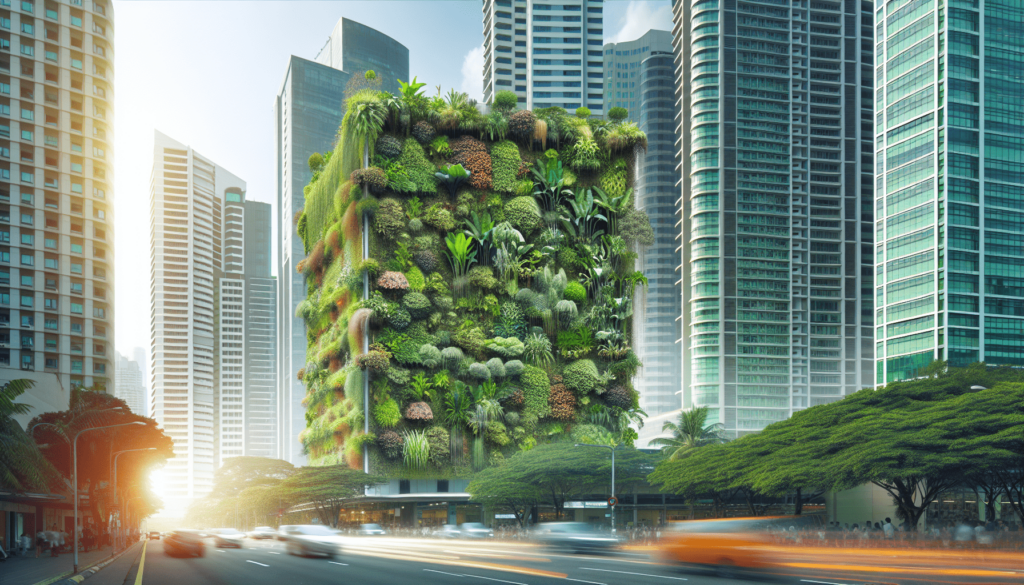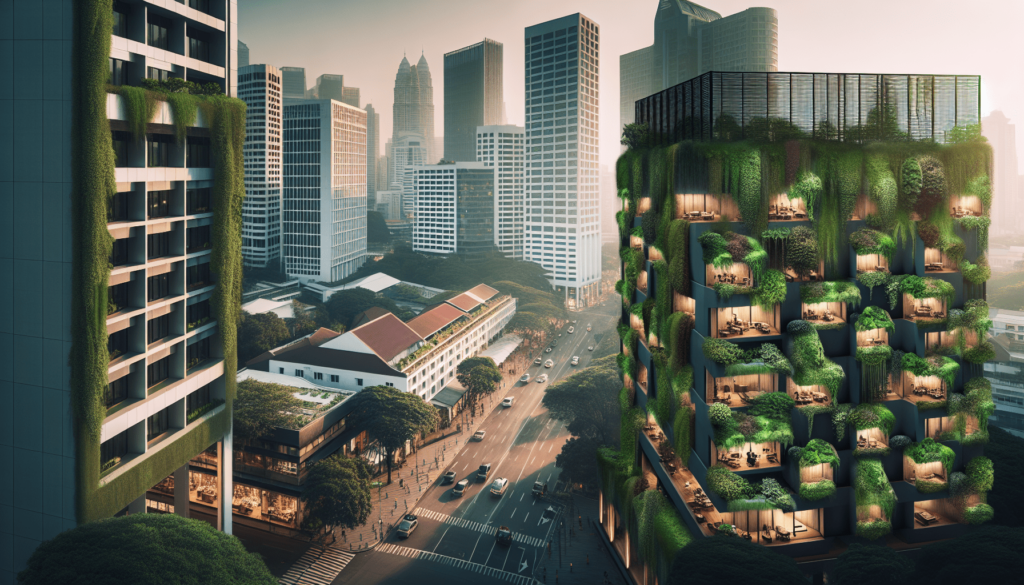Disclosure: As participants in the Amazon Associates Program, we earn from qualifying purchases. This means when you click on an Amazon link on this page and make a purchase, we receive a commission. This doesn’t affect the price you pay but it does help us to keep producing the content you love to see. We always aim for honesty and transparency in everything we do, and your support means the world to us. Thank you for helping us grow and for being part of our community.
Discover the fascinating intersection of nature and architecture as we explore the impact of vertical gardens on building structures. In this informative article, we will delve into the intricate relationship between these stunning green installations and the very foundations that support them. From understanding the potential structural implications to uncovering the benefits these gardens bring, we will guide you through a comprehensive analysis of how vertical gardens can transform not only spaces but also the way we view the built environment. Get ready to explore the innovative world of vertical gardening and unlock the secrets behind their effects on building structures.

This image is property of images.pexels.com.
Introduction
Vertical gardens, also known as green walls or living walls, have become a popular feature in urban environments. These vertical landscapes bring a touch of nature to buildings and contribute to the overall aesthetic appeal of a space. However, it is important to consider how vertical gardens can impact the structures they are attached to. In this article, we will explore the various ways in which vertical gardens can affect building structures and the implications they may have.
Weighing Down Structures
Increased Weight on Walls
One of the primary concerns when it comes to vertical gardens is the additional weight they can impose on the walls of a building. As plants, soil, and the irrigation system add up, the overall weight of the green wall increases significantly. While most modern buildings are designed to withstand certain loads, it is important to consider the structural capacity of the walls before installing a vertical garden. If the walls are not strong enough, the added weight can lead to cracks, bulges, or even collapse.
Additional Load on Foundations
In addition to the increased weight on walls, vertical gardens also place an additional load on the foundations of a building. The weight of the green wall, especially when combined with moisture from watering, can put stress on the foundation and potentially cause structural damage. It is crucial to consult with a structural engineer or architect to assess the building’s foundation and determine if it can support the added load of a vertical garden.

This image is property of images.pexels.com.
Moisture and Water Damage
Potential for Water Seepage
Vertical gardens require regular watering to keep the plants healthy and thriving. However, the accumulation of moisture on the walls can lead to water seepage and subsequent damage. When water seeps into the building’s structure, it can cause mildew, mold growth, and rot in the walls, compromising their integrity. Proper waterproofing measures should be taken to prevent water seepage and protect the building from potential damage.
Deterioration of Building Materials
In addition to water seepage, the constant presence of moisture can cause deterioration of building materials over time. If the walls are not adequately protected against water infiltration, the moisture can penetrate the materials and lead to degradation. Wooden structures can rot, metal elements can rust, and concrete can weaken. Regular maintenance and appropriate waterproofing measures are essential to mitigate the risk of structural damage caused by moisture in vertical gardens.
Structural Integrity
Effect on Building Stability
The additional weight and moisture associated with vertical gardens can have implications for the stability of a building. As the load on the walls and foundation increases, there is a potential risk of compromising the structural integrity of the entire building. It is crucial to ensure that proper measures are taken during the design and installation of vertical gardens to maintain the stability of the structure.
Risk of Structural Damage
If the structural integrity of a building is compromised, there is a higher likelihood of experiencing structural damage. Cracks in walls, bulges, and even collapse can occur if the weight and pressure from the vertical garden exceed the building’s capacity. Regular inspections and monitoring of the building’s condition are necessary to identify any signs of structural damage and address them promptly.

This image is property of images.pexels.com.
Thermal Insulation
Temperature Regulation
One of the advantages of vertical gardens is their ability to provide thermal insulation to buildings. The plants and the growing medium act as natural insulators, reducing the transfer of heat between the interior and exterior of the building. This can lead to more stable indoor temperatures, reducing reliance on heating and cooling systems and ultimately, reducing energy consumption.
Reduced Energy Consumption
By improving thermal insulation, vertical gardens can contribute to a significant reduction in energy consumption. The reduced need for heating and cooling systems translates into energy savings and lower utility bills. Additionally, the shading effect provided by the vertical garden can reduce direct sunlight exposure, further reducing the need for air conditioning during hot summer months.
Protective Barrier
Shielding from Sunlight
Vertical gardens create a protective barrier between the building and direct sunlight. The vegetation acts as a natural shield, reducing the amount of sunlight that penetrates through the walls and windows. This can help regulate indoor temperatures, prevent overheating, and minimize the need for excessive air conditioning.
Minimizing Noise Pollution
Another benefit of vertical gardens is their ability to absorb and reduce noise pollution. The plants and the growing medium act as sound insulation, effectively minimizing the impact of external noises on the building. This can create a more peaceful and serene environment, especially for buildings located in busy urban areas.

Fire Hazard
Increased Fire Risk
Although vertical gardens can provide numerous benefits, it is important to be aware of the potential fire hazards they may pose. The presence of plants and vegetation can increase the fuel load within a building. In the event of a fire, the vertical garden can act as a fuel source, accelerating the spread of flames and making it more challenging for firefighters to control the situation.
Challenges for Firefighters
Vertical gardens can also present challenges for firefighters in terms of access and water supply. The dense vegetation and intricate irrigation systems can impede their ability to reach the fire and quickly extinguish it. Fire safety measures must be carefully considered and implemented to mitigate the fire risk associated with vertical gardens.
Maintenance and Upkeep
Regular Inspection
To ensure the longevity and safety of a vertical garden and its impact on building structures, regular inspections are essential. Monitoring the condition of the walls, foundation, and irrigation system can help identify any signs of damage or deterioration. Prompt maintenance and repairs can prevent further issues and minimize the potential impact on the building.
Cleaning and Pruning
In addition to regular inspections, proper cleaning and pruning of the vertical garden are necessary to maintain its health and prevent overgrowth. Dead leaves, debris, and pests should be regularly removed to avoid any potential damage to the building or the plants themselves. Pruning the plants helps manage their growth and prevents them from exerting excessive pressure on the walls or interfering with nearby structures.

Structural Adaptations
Reinforcement and Modifications
In some cases, buildings may require structural adaptations to accommodate the installation of a vertical garden. Reinforcements and modifications may be needed to ensure the walls and foundation can withstand the additional weight and pressure. Consulting with a structural engineer or architect is crucial to determine the necessary adjustments and ensure the safety of both the vertical garden and the building.
Integration of Irrigation Systems
The integration of irrigation systems is essential for the well-being of plants in a vertical garden. However, it is important to consider the impact of the irrigation system on the building’s structure. Proper waterproofing, drainage, and water management systems should be in place to prevent water damage and ensure the longevity of the vertical garden and the building.
Aesthetics and Property Value
Enhancing Visual Appeal
One of the undeniable benefits of vertical gardens is their impact on the aesthetic appeal of a building. They transform plain walls into vibrant, living landscapes, adding a touch of nature and beauty to urban environments. Vertical gardens can significantly enhance the visual appeal of a property, making it more attractive to residents, tenants, and visitors.
Positive Impact on Real Estate Value
Vertical gardens have the potential to increase the value of a property. The unique and captivating feature they provide can differentiate a building from others in the market, making it more desirable and potentially commanding a higher price. Furthermore, the energy-saving and environmental benefits associated with vertical gardens can be appealing to environmentally conscious buyers or tenants.
In conclusion, vertical gardens can have various impacts on building structures. While they enhance the visual appeal of a space and provide numerous benefits, it is important to consider the potential challenges and implications associated with their installation. Through proper planning, regular maintenance, and consideration of structural integrity, vertical gardens can be enjoyed without compromising the safety and stability of the buildings they adorn.







